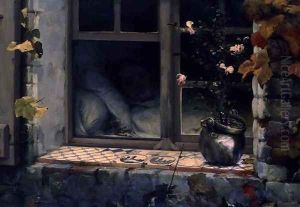Francois Tattegrain Paintings
François Tattegrain was a French painter born on April 28, 1852, in Arras, France. He is known for his contributions to the naturalist movement, which was an approach to art that sought to depict the world realistically without idealization. Tattegrain's work often focused on rural and peasant subjects, reflecting the naturalist interest in everyday life and the social conditions of the time.
Tattegrain studied at the École des Beaux-Arts in Paris and was a student of the academic painters Alexandre Cabanel and Isidore Pils. During his early career, he adhered to the academic standards of the time, which emphasized the importance of drawing and the representation of classical themes. Despite his academic background, Tattegrain later shifted towards naturalism, influenced by the works of Jules Bastien-Lepage and the writings of Emile Zola, who was a prominent advocate for the naturalist movement in literature.
Throughout his career, Tattegrain exhibited his paintings at the Paris Salon, an official art exhibition of the Académie des Beaux-Arts in Paris. His works were well received, and he garnered recognition and awards. Some of his notable paintings include 'Les Veuves de la Mer' (The Widows of the Sea) and 'Après la défaite' (After the Defeat), which reflect his interest in capturing the struggles and resilience of ordinary people.
In addition to his paintings, Tattegrain also created illustrations for books, demonstrating his versatility as an artist. His illustrations contributed to the visual culture of the time and complemented the narratives of the books they accompanied.
François Tattegrain passed away on January 1, 1915, in Paris. Although not as widely known today as some of his contemporaries, his work remains an important part of the naturalist tradition in French painting. His paintings continue to be appreciated for their honest portrayal of rural life and the human condition during the late 19th and early 20th centuries.
